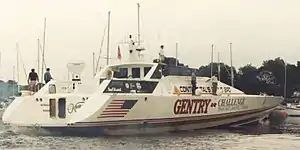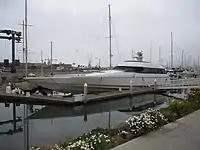Virgin Atlantic Challenge Trophy
The Virgin Atlantic Challenge Trophy is an award for the fastest trans-Atlantic crossing by a surface vessel, one of several such awards that have grown out of the contest for the prestigious Blue Riband of the Atlantic. The trophy was created following Richard Branson's record-breaking Atlantic crossing in 1986 and the refusal by the American Merchant Marine Museum to surrender the Hales Trophy, the then only official award for the Atlantic crossing record. The Virgin Atlantic Challenge Trophy is currently held by the Aga Khan's vessel, Destriero.
Background
The Blue Riband of the Atlantic was a contest between Atlantic passenger shipping companies and their express liners to achieve the fastest average speed on a commercial crossing. The contest was unofficial, involving no set rules or tangible award, and was undertaken for the prestige the accolade brought. In 1935 British businessman Harold Hales created the Hales Trophy. It passed to the owners of several express liners, though not to Cunard, owner of the record-breaking Queen Mary, and was won in 1952 by the American Lines liner United States. Thereafter the competition lapsed due to the rapid rise of transatlantic air travel, and United States herself was laid up in 1969.
In 1985 British entrepreneur Richard Branson's attempt to break the United States's record and win the Blue Riband led to the building of Virgin Atlantic Challenger, which failed in a crossing in July of that year. In 1986. a second attempt by Branson, in Virgin Atlantic Challenger II, set a new speed record, but the American Merchant Marine Museum refused to surrender the Hales Trophy, claiming Challenger was not a commercial passenger ship. Undaunted, Branson had a new trophy made, making it a challenge trophy open to any who could beat Virgin Atlantic Challenger's record.
The trophy

The Virgin Atlantic Challenge Trophy is a three-foot silver sculpture, modelled on the Bishop Rock Lighthouse, chosen as the finishing line for many of the Blue Riband crossings, and of the successful 1986 voyage. The model depicts the lighthouse and the rock itself.
History
Branson's first attempt on the record, in 65 ft twin-hull Virgin Atlantic Challenger, departed New York in June 1985. After surviving rough weather and the threat of late icebergs Challenger was fatally damaged by striking a submerged object 100 miles from Bishops Rock, the intended finishing line, and sank in heavy seas.[1] All the crew were saved. The following year, in a new craft, the 72 ft monohull Virgin Atlantic Challenger II, Branson completed the crossing in three days, eight hours and 31 minutes, averaging just under 36 knots; he thus shaved two hours and nine minutes off the time set by United States in 1952. Branson had unfurled a six-foot blue pennant to mark the achievement, and announced “we are throwing down the gauntlet for anyone else to make a transatlantic challenge and beat it”,[2] but the AMMM later derided his achievement, referring to Challenger as “a little toy boat”. In response to this Branson decided to commission the new trophy, open to all challengers.
In 1988 a new challenge was planned by Paolo Vitelli, in a 100 ft monohull, Azimut Atlantic Challenger, but this attempt came to nothing.[3]

That same year American businessman Tom Gentry made an attempt in his 110 ft powerboat Gentry Eagle, (which cost $7 million in 1988[4] ($14 million in 2021 dollars[5]) and was fitted with twin 3,480 hp MTU V396 TB94s turbocharged marine diesel engines, in addition to a single 4,500-horsepower Textron Lycoming TF40 marine turbine engine for a total of 11,500 horsepower)[6] but she was damaged by heavy seas off Newfoundland and forced to turn back. Gentry's aim was to “bring blue riband home”, which he achieved the following year. His second attempt in July 1989 saw Gentry Eagle cross the line in 62 hours 7 minutes, at an average speed of 47.4 knots (54.5 mph), exceeding Branson's record by almost a quarter.[7] Gentry was met at St. Mary's, Isles of Scilly, by Branson and warmly congratulated; he subsequently received the trophy to mark his achievement.

In 1991 it was reported that three challengers were under construction; a new boat, Eagle II from Gentry, North East Spirit from Richard Noble, the land speed record holder, and Destriero, from the Aga Khan.[8]
In the event, only Destriero made the crossing, setting a new record with an average speed of 53 knots (the time was not comparable, as the route taken, from Tarifa, Spain to New York, was longer).
Despite rumours of new challengers with radical hull designs Destriero's record remains unbroken.
See also
References
- Thomas, Jo (16 August 1985). "Powerboat Sinks Just Hours from Breaking Atlantic Speed Record". The New York Times.
- Branson captures Blue Riband-Virgin Challenger Atlantic crossing Nicolas Beeston, 30 June 1986 The Times; retrieved 3 August 2017
- A rich man's quest for the blue riband 24 June 1988 The Times;retrieved 3 August 2017
- Archived at Ghostarchive and the Wayback Machine: Atlantic Crossing Record - Gentry Eagle 1989. YouTube.
- Johnston, Louis; Williamson, Samuel H. (2023). "What Was the U.S. GDP Then?". MeasuringWorth. Retrieved January 1, 2023. United States Gross Domestic Product deflator figures follow the Measuring Worth series.
- Reinhart, John (2012-01-01). "The World's Fastes Yacht—Is In Your Backyard - The little known story of Gentry Eagle". Southland Publishing. Archived from the original on 2012-01-31. Retrieved 2018-10-29.
Gentry Eagle is powered by 11,500 horses... Gentry met with the renowned performance boat engineer Peter Birkett, who actually designed Virgin Challenger, Branson's Blue Riband winning boat. Together they came up with an aluminum deep-V hull, an engine room packed with two MTU 16V396 TB94s sequentially turbocharged marine diesel engines and a 4,500 horsepower Textron Lycoming marine turbine, and an Arneson surface drive strapped on the back. All that marine jargon has a simple translation: burning speed. To deal with the horrific beating the hull would take during a high-speed crossing, Gentry employed Vosper Thornycroft LTD, a company known for building destroyers, frigates, and fast attack craft. The boat was welded using a meta-lax sub-harmonic stress relieving process.
- Eagle wings its way to a transatlantic record Barry Pickthall, Dave Sansted, 28 July 1989 The Times;retrieved 3 August 2017
- Challenge awaits high-powered trio Barry Pickthall, 12 April 1991 The Times;retrieved 3 August 2017
External links
- Atlantic Challenger The Onboard Story 1985 failed attempt: a Tomorrows World Special (47 mins) Peter MaCann
- Virgin Atlantic Challenger II Making the Record 1986 Tomorrows World Special (34 mins) Peter MaCann
- Gentry Eagle 1989 Atlantic Crossing Record (6 mins) at YouTube
- Destriero Blue Riband 1992 (4 mins) (Finnish) at YouTube